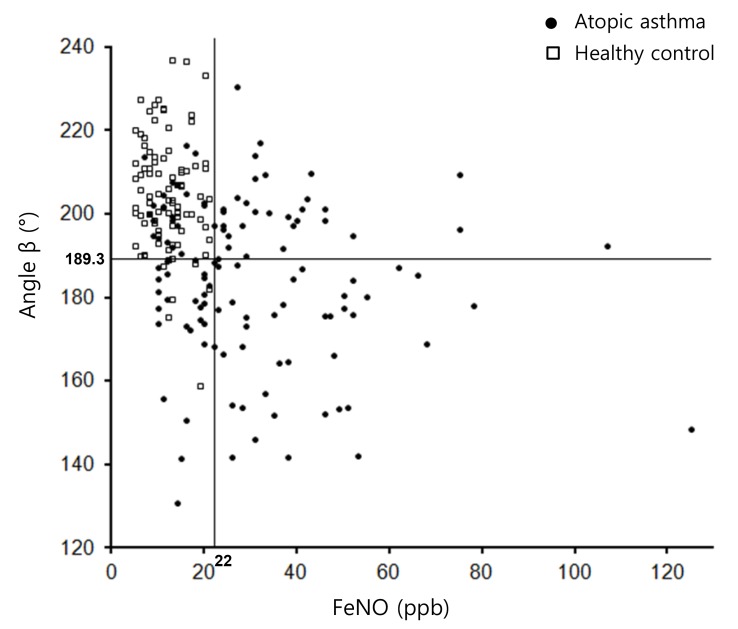1. National Asthma Education and Prevention Program. Expert Panel Report 3 (EPR-3): Guidelines for the Diagnosis and Management of Asthma-Summary Report 2007. J Allergy Clin Immunol 2007;120(5 Suppl): S94ŌĆōS138.


2. Global Initiative for Asthma (GINA). Global burden of asthma [Internet]. The Global Initiative for Asthma, cited 2016 Oct 20. Available from:
http://www.ginasthma.com.
3. Pellegrino R, Viegi G, Brusasco V, Crapo RO, Burgos F, Casaburi R, et al. Interpretative strategies for lung function tests. Eur Respir J 2005;26:948ŌĆō968.


4. Linna O. A doctor's ability to assess the severity of childhood asthma by simple clinical features. Acta Paediatr 2005;94:559ŌĆō563.


5. Ohwada A, Takahashi K. Concave pattern of a maximal expiratory flow-volume curve: a sign of airflow limitation in adult bronchial asthma. Pulm Med 2012;2012:797495.


6. Gelb AF, Zamel N. Simplified diagnosis of small-airway obstruction. N Engl J Med 1973;288:395ŌĆō398.


7. Kapp MC, Schachter EN, Beck GJ, Maunder LR, Witek TJ Jr. The shape of the maximum expiratory flow volume curve. Chest 1988;94:799ŌĆō806.


8. ├¢zkan M, Dweik RA. Nitric oxide and airway reactivity. Clin Pulm Med 2001;8:199ŌĆō206.

9. Smith AD, Cowan JO, Filsell S, McLachlan C, Monti-Sheehan G, Jackson P, et al. Diagnosing asthma: comparisons between exhaled nitric oxide measurements and conventional tests. Am J Respir Crit Care Med 2004;169:473ŌĆō478.


10. Deykin A, Massaro AF, Drazen JM, Israel E. Exhaled nitric oxide as a diagnostic test for asthma: online versus offline techniques and effect of flow rate. Am J Respir Crit Care Med 2002;165:1597ŌĆō1601.


11. Dupont LJ, Demedts MG, Verleden GM. Prospective evaluation of the validity of exhaled nitric oxide for the diagnosis of asthma. Chest 2003;123:751ŌĆō756.


14. Woo SI, Lee JH, Kim H, Kang JW, Sun YH, Hahn YS. Utility of fractional exhaled nitric oxide (F(E)NO) measurements in diagnosing asthma. Respir Med 2012;106:1103ŌĆō1109.


16. American Thoracic Society. European Respiratory Society. ATS/ERS recommendations for standardized procedures for the online and offline measurement of exhaled lower respiratory nitric oxide and nasal nitric oxide, 2005. Am J Respir Crit Care Med 2005;171:912ŌĆō930.


17. Miller MR, Hankinson J, Brusasco V, Burgos F, Casaburi R, Coates A, et al. Standardisation of spirometry. Eur Respir J 2005;26:319ŌĆō338.


18. Hankinson JL, Odencrantz JR, Fedan KB. Spirometric reference values from a sample of the general U.S. population. Am J Respir Crit Care Med 1999;159:179ŌĆō187.


19. DeLong ER, DeLong DM, Clarke-Pearson DL. Comparing the areas under two or more correlated receiver operating characteristic curves: a nonparametric approach. Biometrics 1988;44:837ŌĆō845.


20. Zhang Y, McConnell R, Gilliland F, Berhane K. Ethnic differences in the effect of asthma on pulmonary function in children. Am J Respir Crit Care Med 2011;183:596ŌĆō603.


21. N├©ve V, Matran R, Baquet G, Methlin CM, Delille C, Boulenguez C, et al. Quantification of shape of flow-volume loop of healthy preschool children and preschool children with wheezing disorders. Pediatr Pulmonol 2012;47:884ŌĆō894.


22. Malmberg LP, Pet├żys T, Haahtela T, Laatikainen T, Jousilahti P, Vartiainen E, et al. Exhaled nitric oxide in healthy nonatopic school-age children: determinants and height-adjusted reference values. Pediatr Pulmonol 2006;41:635ŌĆō642.


23. Kharitonov SA, Gonio F, Kelly C, Meah S, Barnes PJ. Reproducibility of exhaled nitric oxide measurements in healthy and asthmatic adults and children. Eur Respir J 2003;21:433ŌĆō438.


26. Eigen H, Bieler H, Grant D, Christoph K, Terrill D, Heilman DK, et al. Spirometric pulmonary function in healthy preschool children. Am J Respir Crit Care Med 2001;163(3 Pt 1): 619ŌĆō623.








 PDF Links
PDF Links PubReader
PubReader ePub Link
ePub Link PubMed
PubMed Download Citation
Download Citation


